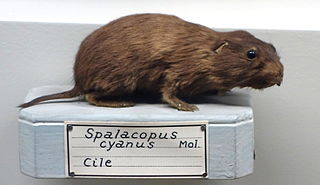Kirchner, a surname of German origin, from the Middle High German word, 'kirchenaere'. Kirchner originated as an occupational surname for a church worker, such as a priest, church assistant or a church property administrator. Notable people with the name include:

Abrocoma is a genus of abrocomid rodents found in the Andes of South America, from southern Peru to central Chile. The genus contains eight species, most of which are found in isolated mountain ranges in northwestern Argentina. The oldest fossil record for the Caviomorpha appears at the late Eocene-Early Oligocene transition. The Abrocoma has an interesting body structure for example within its own head it has a sac that contains a liquid that is not named by Janet K. Braun and Michael A. Mares(894). They also have feet that are padded which helped to completely say with certainty that it is a rock dweller but also a rock climber.(896).
The golden viscacha rat or golden vizcacha rat is the single species of the genus Pipanacoctomys of the rodent family Octodontidae. It has 92 chromosomes and has been regarded as tetraploid. This octodontid and its sister-species, the plains viscacha rat, may have arisen from the diploid mountain viscacha rat, as a result of the doubling and subsequent loss of some chromosomes. However, some genetic studies have rejected any polyploidism in mammals as unlikely, and suggest that amplification and dispersion of repetitive sequences best explain the large genome size.
Pittier's crab-eating rat is a species of semiaquatic rodent in the family Cricetidae. It is endemic to Venezuela. The natural habitats of this species are rivers and swamps. Its karyotype has 2n = 92 and FNa = 98. This was previously thought to be the highest chromosome number known for a mammal, but it has since been found that the plains viscacha rat or red viscacha rat has 4x = 2n = 102.

Bennett's chinchilla rat is a species of chinchilla rat in the family Abrocomidae. It is found only in Chile where its habitat is Mediterranean-type scrub on the western side of the Andes. The IUCN has assessed its conservation status as being of "least concern".

The Chilean rock rat is a species of rodent in the family Octodontidae. It is found in the high Andes of Argentina and Chile.
Sage's rock rat is a species of rodent in the family Octodontidae. It is found in Argentina and possibly Chile.

The Talas tuco-tuco is a species of tuco-tuco endemic to eastern Argentina.

The plains viscacha or plains vizcacha is a species of viscacha, a rodent in the family Chinchillidae. It is the only living species within the genus Lagostomus. It is found in Argentina, Bolivia, and Paraguay. The plains viscacha is the largest species in its family. They construct elaborate burrows that house successive colonies for decades.
The mountain viscacha rat or mountain vizcacha rat, historically viscacha rat or vizcacha rat, is a species of rodent in the family Octodontidae. It is endemic to Argentina.

The coruro is a species of rodent in the family Octodontidae. It is the only species in the genus Spalacopus. The species is endemic to central Chile, where it has been found in a wide variety of habitats, from coastal to montane. It is fossorial and lives in colonies.

The plains viscacha rat, plains vizcacha rat, red viscacha rat, or red vizcacha rat is a species of rodent in the family Octodontidae native to Argentina. It is one of three species in the genus Tympanoctomys.

Tympanoctomys is a genus of rodent in the family Octodontidae. There are three extant species in the genus: T. barrerae, T. kirchnerorum and T. loschalchalerosorum. T. loschalchalerosorum was formerly considered to be monotypic within the genus Salinoctomys, but has been shown by genetic analysis to nest within the variation of T. barrerae.
Viscacha rats are a group of rodents in the family Octodontidae. All species are found in Argentina. They are placed in the following genera:
Porter's rock rat is a species of rodent in the family Octodontidae. It is found in Argentina and Chile at altitudes between 900 and 2,000 meters above sea level.

Octodontidae is a family of rodents, restricted to southwestern South America. Fourteen species of octodontid are recognised, arranged in seven genera. The best known species is the common degu, Octodon degus.
The Chalchalero viscacha rat or Chalchalero vizcacha rat is a species of caviomorph rodent in the family Octodontidae. It was formerly considered to be monotypic within the genus Salinoctomys, but has been shown by genetic analysis to nest within Tympanoctomys, and in particular, within the variation of T. barrerae. The species is endemic to a small area of northwestern Argentina, where it lives in shrublands bordering the salt flats of the Salinas Grandes. Its diet consists of halophyte plants. It is named after an Argentine musical group, Los Chalchaleros, whose songs were popular with its discoverers.
The Argentine swamp rat is a semiaquatic rodent species from South America. It is found in northeastern Argentina and Paraguay, where it lives in freshwater marshes and along the southern coast of the Río de la Plata estuary, as well as in woodland. It is characterized by having stiff hairs on its otherwise naked tail, which are believed to help the animal swim. S. aquaticus is similar in build to members of the genus Rattus. "[It] has a relatively larger head, a stouter body, larger feet, and a relatively longer tail." The pelage along its back is "long and glossy" varying from brown to dark brown. It can have a grayish wash in some individuals. "The sides have a yellowish cast." The pelage in the abdominal region is typically an off white color. The forefeet are large for use in swimming and digging. All digits, including the pollex are equipped with a claw. Its karyotype has 2n = 32.
Bridges's degu is a species of rodent in the family Octodontidae. It is found in southern Chile. The species was named after Thomas Bridges.







